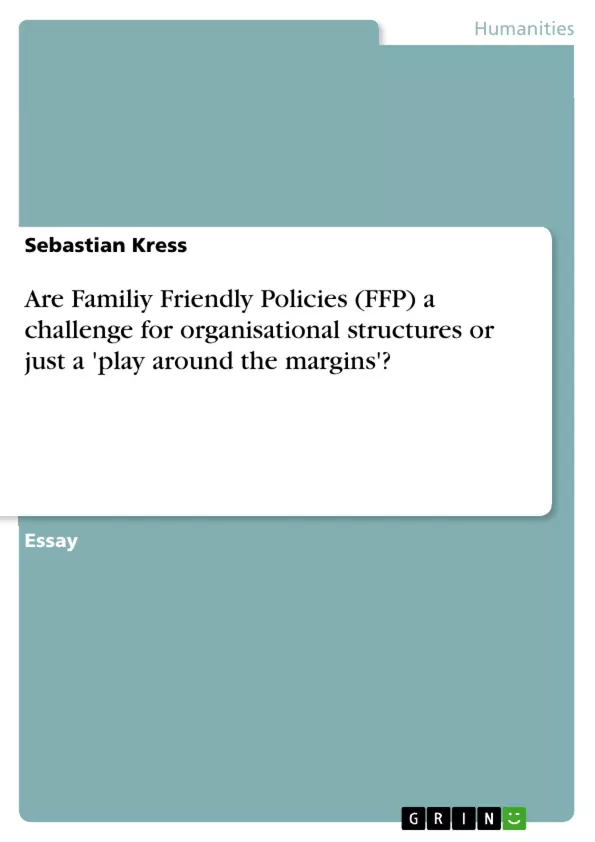Erstwhile, men were considered as the family breadwinners and women as the homemakers. These assumptions were deep seated and were still considered as apposite even some decades ago (Allard, Haas and Hwang, 2011) and were fostered by renowned scholars that found that work and family life could be regarded as separate spheres (Kanter, 1977). Yet, it is widely accepted that work and family life influence each other in both directions (Frone, Russell and Cooper, 1992), that spill over happens between the spheres (Boles, Johnston and Hair, 1997), and that the spheres either overlap or interact with each other (Barnett, 1999). Moreover, the research to date has tended to focus on the mothers and fathers having the same requirements to balance their work and family needs in their daily lives (Van der Lippe, Jager and Kops, 2006). Although, there have been seen substantial changes in gender equality on the labour market, there is still a gender gap prevailing in wages and women’s representation in positions with responsibility (Vandeweyer and Glorieux, 2008; Wilton and Purcell, 2010). Albeit, men perform more housework and childcare than they did in the past, the dispersal of paid and unpaid work is still strongly genderbased (Gershuny, Bittman and Brice, 2005; Sayer, 2005). Further, men tend to work longer hours, have more prestigious positions in companies and earn more money than women do which leads to the result that men and women have different economic
opportunities and constraints (Wilton, 2007).
Inhaltsverzeichnis (Table of Contents)
- INTRODUCTION.
- DETERMINE KEY TERMINOLOGY
- ORGANISATION'S CULTURE AND STRUCTURE.
- WORK-FAMILY CONFLICT.
- FAMILY FRIENDLY POLICIES.
- LEGAL SITUATION IN THE UNITED KINGDOM.
- FAMILY FRIENDLY POLICIES IN ORGANISATIONS
- ACCEPTANCE OF FAMILY FRIENDLY POLICIES BY EMPLOYEES.
- OBSTACLE TO FUNDAMENTAL CHANGE WITHIN ORGANISATIONS.
- POTENTIAL METHODS OF RESOLUTION.
- CONCLUSION.
Zielsetzung und Themenschwerpunkte (Objectives and Key Themes)
This text critically examines the effectiveness of Family Friendly Policies (FFP) in challenging traditional organisational structures and cultures. It aims to understand whether these policies are truly promoting work-family balance or merely addressing the issue on a superficial level.
- The influence of organisational culture and structure on work-family balance.
- The impact of gendered norms and the 'ideal worker' concept on work-family conflicts.
- The challenges of implementing FFP and their potential effectiveness in fostering change within organisations.
- The role of legal frameworks in shaping work-family policies and practices.
- The potential methods for resolving work-family conflicts and achieving greater balance.
Zusammenfassung der Kapitel (Chapter Summaries)
The introduction highlights the changing landscape of work-family dynamics and the need for policies that support both individual and organisational needs. It discusses the historical context of traditional gender roles and how they have influenced work-family relations.
The second chapter defines key terms such as organisational culture, structure, and work-family conflict. It delves into the complex interplay between culture and values, emphasizing the challenges of changing ingrained beliefs and practices.
The third chapter focuses on the legal situation in the UK concerning work-family balance, outlining key legislation and policies that aim to support working parents and carers.
The fourth chapter examines the implementation of FFP within organisations, exploring the acceptance of these policies by employees and the obstacles that hinder their effectiveness in creating a truly inclusive work environment.
Schlüsselwörter (Keywords)
Family Friendly Policies, organisational culture, organisational structure, work-family conflict, gendered norms, ideal worker, legal frameworks, work-life balance, employee engagement, inclusive workplaces.
- Arbeit zitieren
- Sebastian Kress (Autor:in), 2012, Are Familiy Friendly Policies (FFP) a challenge for organisational structures or just a 'play around the margins'?, München, GRIN Verlag, https://www.grin.com/document/192531



